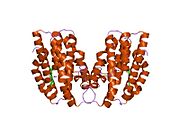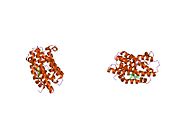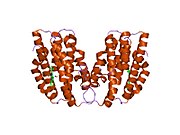HMOX1
| HMOX1 | |||||||||||||||||||||||||||||||||||||||||||||||||||
|---|---|---|---|---|---|---|---|---|---|---|---|---|---|---|---|---|---|---|---|---|---|---|---|---|---|---|---|---|---|---|---|---|---|---|---|---|---|---|---|---|---|---|---|---|---|---|---|---|---|---|---|
 | |||||||||||||||||||||||||||||||||||||||||||||||||||
| |||||||||||||||||||||||||||||||||||||||||||||||||||
| Identifiers | |||||||||||||||||||||||||||||||||||||||||||||||||||
| Aliases | HMOX1, HMOX1D, HO-1, HSP32, bK286B10, heme oxygenase 1 | ||||||||||||||||||||||||||||||||||||||||||||||||||
| External IDs | OMIM: 141250; MGI: 96163; HomoloGene: 31075; GeneCards: HMOX1; OMA:HMOX1 - orthologs | ||||||||||||||||||||||||||||||||||||||||||||||||||
| |||||||||||||||||||||||||||||||||||||||||||||||||||
| |||||||||||||||||||||||||||||||||||||||||||||||||||
| |||||||||||||||||||||||||||||||||||||||||||||||||||
| |||||||||||||||||||||||||||||||||||||||||||||||||||
| |||||||||||||||||||||||||||||||||||||||||||||||||||
| Wikidata | |||||||||||||||||||||||||||||||||||||||||||||||||||
| |||||||||||||||||||||||||||||||||||||||||||||||||||
HMOX1 (heme oxygenase 1 gene) is a human gene that encodes for the enzyme heme oxygenase 1 (EC 1.14.99.3). Heme oxygenase (abbreviated HMOX or HO) mediates the first step of heme catabolism, it cleaves heme to form biliverdin.
The HMOX gene is located on the long (q) arm of chromosome 22 at position 12.3, from base pair 34,101,636 to base pair 34,114,748.
Related conditions
- Heme oxygenase-1 deficiency
Heme oxygenase
Heme oxygenase, an essential enzyme in heme catabolism, cleaves heme to form biliverdin, carbon monoxide, and ferrous iron.[5] The biliverdin is subsequently converted to bilirubin by biliverdin reductase. Heme oxygenase activity is induced by its substrate heme and by various nonheme substances. Heme oxygenase occurs as 2 isozymes, an inducible heme oxygenase-1 and a constitutive heme oxygenase-2. HMOX1 and HMOX2 belong to the heme oxygenase family.[6]
See also
References
- ^ a b c GRCh38: Ensembl release 89: ENSG00000100292 – Ensembl, May 2017
- ^ a b c GRCm38: Ensembl release 89: ENSMUSG00000005413 – Ensembl, May 2017
- ^ "Human PubMed Reference:". National Center for Biotechnology Information, U.S. National Library of Medicine.
- ^ "Mouse PubMed Reference:". National Center for Biotechnology Information, U.S. National Library of Medicine.
- ^ Lehninger's Principles of Biochemistry, 5th Edition. New York: W.H. Freeman and Company. 2008. pp. 876. ISBN 978-0-7167-7108-1.
- ^ "Entrez Gene: HMOX1 heme oxygenase (decycling) 1".
Further reading
- Yachie A, Niida Y, Wada T, Igarashi N, Kaneda H, Toma T, Ohta K, Kasahara Y, Koizumi S (1999). "Oxidative stress causes enhanced endothelial cell injury in human heme oxygenase-1 deficiency". J Clin Invest. 103 (1): 129–35. doi:10.1172/JCI4165. PMC 407858. PMID 9884342.
- Zhang Z, Song Y, Zhang Z, Li D, Zhu H, Liang R, Gu Y, Pang Y, Qi J, Wu H, Wang J (2016). "Distinct role of heme oxygenase-1 in early- and late-stage intracerebral hemorrhage in 12-month-old mice". J Cereb Blood Flow Metab. 37 (1): 25–38. doi:10.1177/0271678X16655814. PMC 5363754. PMID 27317654.
- Wang J, Doré S (2007). "Heme oxygenase-1 exacerbates early brain injury after intracerebral haemorrhage". Brain. 130 (6): 1643–52. doi:10.1093/brain/awm095. PMC 2291147. PMID 17525142.
- Soares MP, Brouard S, Smith RN, Bach FH (2002). "Heme oxygenase-1, a protective gene that prevents the rejection of transplanted organs". Immunol. Rev. 184: 275–85. doi:10.1034/j.1600-065x.2001.1840124.x. PMID 12086318. S2CID 5876166.
- Morse D, Choi AM (2002). "Heme oxygenase-1: the "emerging molecule" has arrived". Am. J. Respir. Cell Mol. Biol. 27 (1): 8–16. doi:10.1165/ajrcmb.27.1.4862. PMID 12091240.
- Buelow R, Tullius SG, Volk HD (2002). "Protection of grafts by hemoxygenase-1 and its toxic product carbon monoxide". Am. J. Transplant. 1 (4): 313–5. doi:10.1034/j.1600-6143.2001.10404.x. PMID 12099373. S2CID 41282418.
- Ishikawa K (2003). "Heme oxygenase-1 against vascular insufficiency: roles of atherosclerotic disorders". Curr. Pharm. Des. 9 (30): 2489–97. doi:10.2174/1381612033453767. PMID 14529548.
- Exner M, Minar E, Wagner O, Schillinger M (2005). "The role of heme oxygenase-1 promoter polymorphisms in human disease". Free Radic. Biol. Med. 37 (8): 1097–104. doi:10.1016/j.freeradbiomed.2004.07.008. PMID 15451051.
- Ozono R (2006). "New biotechnological methods to reduce oxidative stress in the cardiovascular system: focusing on the Bach1/heme oxygenase-1 pathway". Current Pharmaceutical Biotechnology. 7 (2): 87–93. doi:10.2174/138920106776597630. PMID 16724942.
- Tracz MJ, Alam J, Nath KA (2007). "Physiology and pathophysiology of heme: implications for kidney disease". J. Am. Soc. Nephrol. 18 (2): 414–20. doi:10.1681/ASN.2006080894. PMID 17229906.
- Chang CF, Cho S, Wang J (2014). "(-)-Epicatechin protects hemorrhagic brain via synergistic Nrf2 pathways". Annals of Clinical and Translational Neurology. 1 (4): 258–271. doi:10.1002/acn3.54. PMC 3984761. PMID 24741667.
- Hill-Kapturczak N, Agarwal A (2007). "Haem oxygenase-1--a culprit in vascular and renal damage?". Nephrol. Dial. Transplant. 22 (6): 1495–9. doi:10.1093/ndt/gfm093. PMID 17389623.
External links
- Overview of all the structural information available in the PDB for UniProt: P09601 (Heme oxygenase 1) at the PDBe-KB.
- v
- t
- e
-
 1n3u: Crystal structure of human heme oxygenase 1 (HO-1) in complex with its substrate heme, crystal form B
1n3u: Crystal structure of human heme oxygenase 1 (HO-1) in complex with its substrate heme, crystal form B -
 1n45: X-RAY CRYSTAL STRUCTURE OF HUMAN HEME OXYGENASE-1 (HO-1) IN COMPLEX WITH ITS SUBSTRATE HEME
1n45: X-RAY CRYSTAL STRUCTURE OF HUMAN HEME OXYGENASE-1 (HO-1) IN COMPLEX WITH ITS SUBSTRATE HEME -
 1ni6: Comparisons of the Heme-Free and-Bound Crystal Structures of Human Heme Oxygenase-1
1ni6: Comparisons of the Heme-Free and-Bound Crystal Structures of Human Heme Oxygenase-1 -
 1oyk: Crystal Structures of the Ferric, Ferrous, and Ferrous-NO Forms of the Asp140Ala Mutant of Human Heme Oxygenase-1: Catalytic Implications
1oyk: Crystal Structures of the Ferric, Ferrous, and Ferrous-NO Forms of the Asp140Ala Mutant of Human Heme Oxygenase-1: Catalytic Implications -
 1oyl: Crystal Structures of the Ferric, Ferrous, and Ferrous-NO Forms of the Asp140Ala Mutant of Human Heme Oxygenase-1: Catalytic Implications
1oyl: Crystal Structures of the Ferric, Ferrous, and Ferrous-NO Forms of the Asp140Ala Mutant of Human Heme Oxygenase-1: Catalytic Implications -
 1oze: Crystal Structures of the Ferric, Ferrous, and Ferrous-NO Forms of the Asp140Ala Mutant of Human Heme Oxygenase-1:Catalytic Implications
1oze: Crystal Structures of the Ferric, Ferrous, and Ferrous-NO Forms of the Asp140Ala Mutant of Human Heme Oxygenase-1:Catalytic Implications -
 1ozl: Crystal Structures of the Ferric, Ferrous, and Ferrous-NO Forms of the Asp140Ala Mutant of Human Heme Oxygenase-1: Catalytic Implications
1ozl: Crystal Structures of the Ferric, Ferrous, and Ferrous-NO Forms of the Asp140Ala Mutant of Human Heme Oxygenase-1: Catalytic Implications -
 1ozr: Crystal Structures of the Ferric, Ferrous and Ferrous-NO Forms of the Asp140Ala Mutant of Human Heme Oxygenase-1: Catalytic Implications
1ozr: Crystal Structures of the Ferric, Ferrous and Ferrous-NO Forms of the Asp140Ala Mutant of Human Heme Oxygenase-1: Catalytic Implications -
 1ozw: Crystal Structures of the Ferric, Ferrous and Ferrous-NO Forms of the Asp140Ala Mutant of Human Heme Oxygenase-1: Catalytic Implications
1ozw: Crystal Structures of the Ferric, Ferrous and Ferrous-NO Forms of the Asp140Ala Mutant of Human Heme Oxygenase-1: Catalytic Implications -
 1s13: Human Heme Oxygenase Oxidatition of alpha- and gamma-meso-Phenylhemes
1s13: Human Heme Oxygenase Oxidatition of alpha- and gamma-meso-Phenylhemes -
 1s8c: Crystal structure of human heme oxygenase in a complex with biliverdine
1s8c: Crystal structure of human heme oxygenase in a complex with biliverdine -
 1t5p: Human Heme Oxygenase Oxidation of alpha- and gamma-meso-phenylhemes
1t5p: Human Heme Oxygenase Oxidation of alpha- and gamma-meso-phenylhemes -
 1twn: Crystal structures of ferrous and ferrous-NO forms of verdoheme in a complex with human heme oxygenase-1: catalytic implications for heme cleavage
1twn: Crystal structures of ferrous and ferrous-NO forms of verdoheme in a complex with human heme oxygenase-1: catalytic implications for heme cleavage -
 1twr: Crystal structures of ferrous and ferrous-NO forms of verdoheme in a complex with human heme oxygenase-1: catalytic implications for heme cleavage
1twr: Crystal structures of ferrous and ferrous-NO forms of verdoheme in a complex with human heme oxygenase-1: catalytic implications for heme cleavage -
 1xjz: Crystal Structures of the G139A, G139A-NO and G143H Mutants of Human Heme Oxygenase-1
1xjz: Crystal Structures of the G139A, G139A-NO and G143H Mutants of Human Heme Oxygenase-1 -
 1xk0: Crystal Structures of the G139A, G139A-NO and G143H Mutants of Human Heme Oxygenase-1
1xk0: Crystal Structures of the G139A, G139A-NO and G143H Mutants of Human Heme Oxygenase-1 -
 1xk1: Crystal Structures of the G139A, G139A-NO and G143H Mutants of Human Heme Oxygenase-1
1xk1: Crystal Structures of the G139A, G139A-NO and G143H Mutants of Human Heme Oxygenase-1 -
 1xk2: NADPH- and Ascorbate-Supported Heme Oxygenase Reactions are Distinct. Regiospecificity of Heme Cleavage by the R183E Mutant
1xk2: NADPH- and Ascorbate-Supported Heme Oxygenase Reactions are Distinct. Regiospecificity of Heme Cleavage by the R183E Mutant -
 1xk3: NADPH- and Ascorbate-Supported Heme Oxygenase Reactions are Distinct. Regiospecificity of Heme Cleavage by the R183E Mutant
1xk3: NADPH- and Ascorbate-Supported Heme Oxygenase Reactions are Distinct. Regiospecificity of Heme Cleavage by the R183E Mutant
 | This article on a gene on human chromosome 22 is a stub. You can help Wikipedia by expanding it. |
- v
- t
- e





































